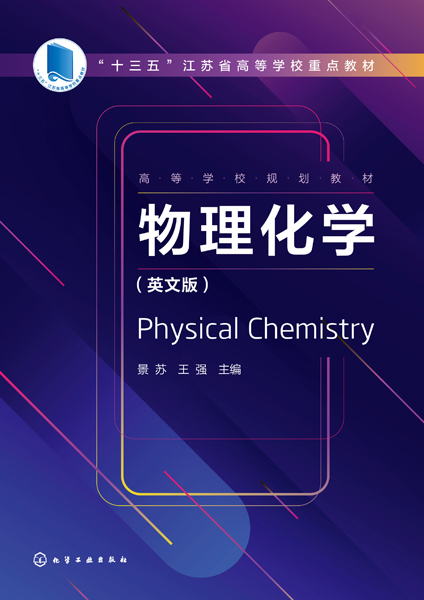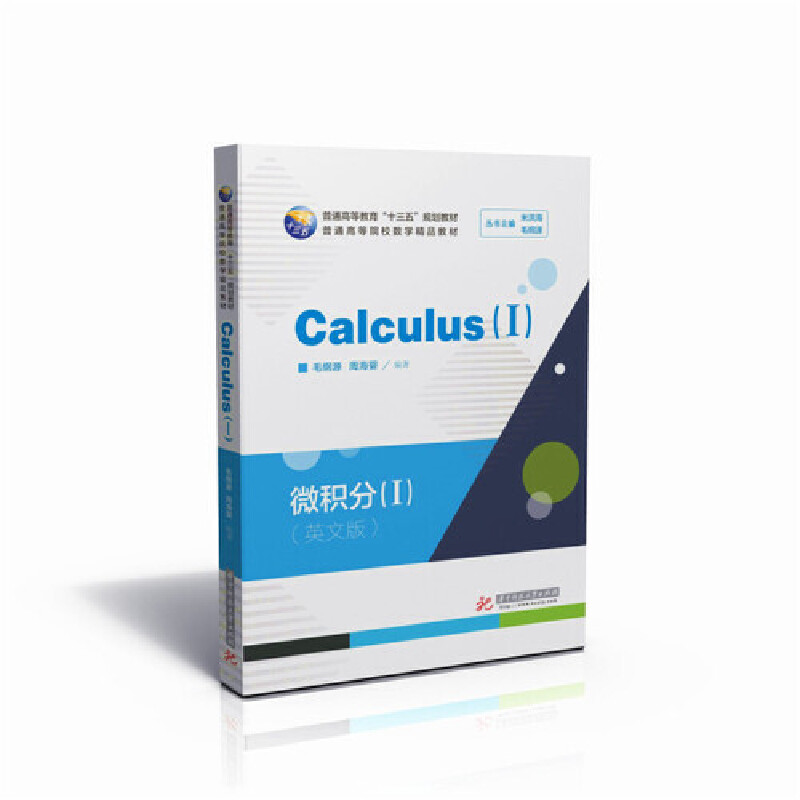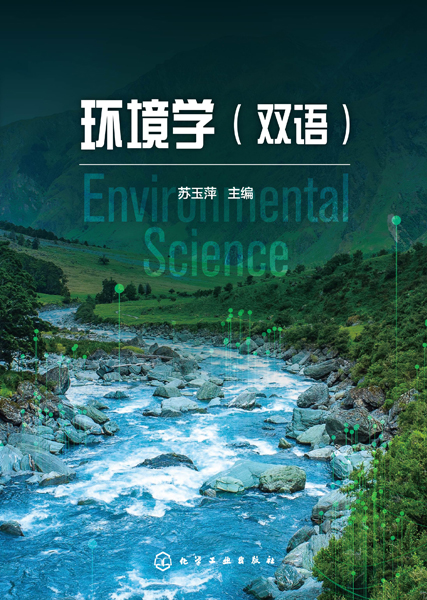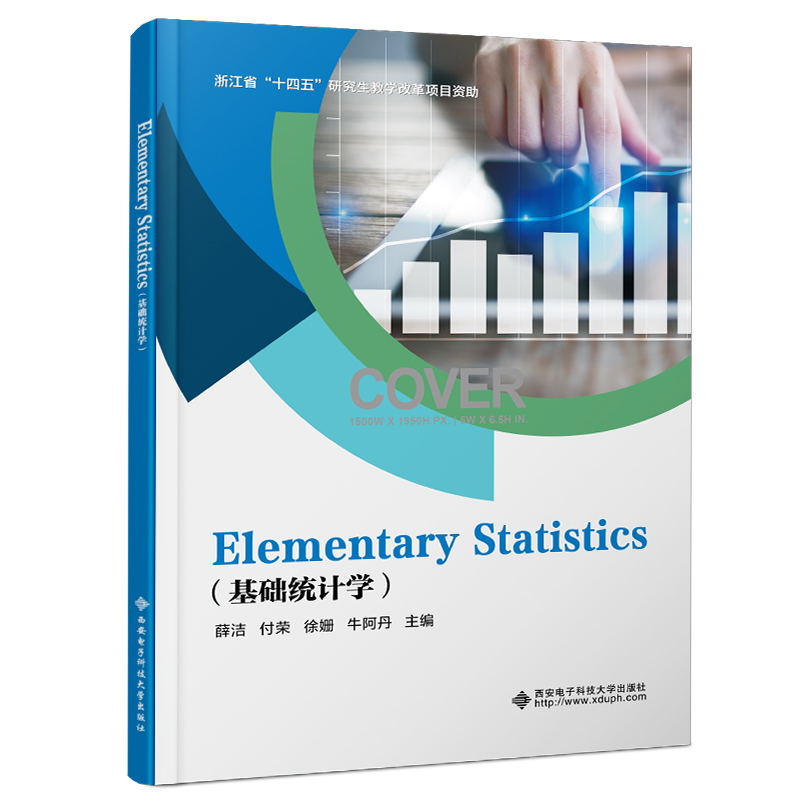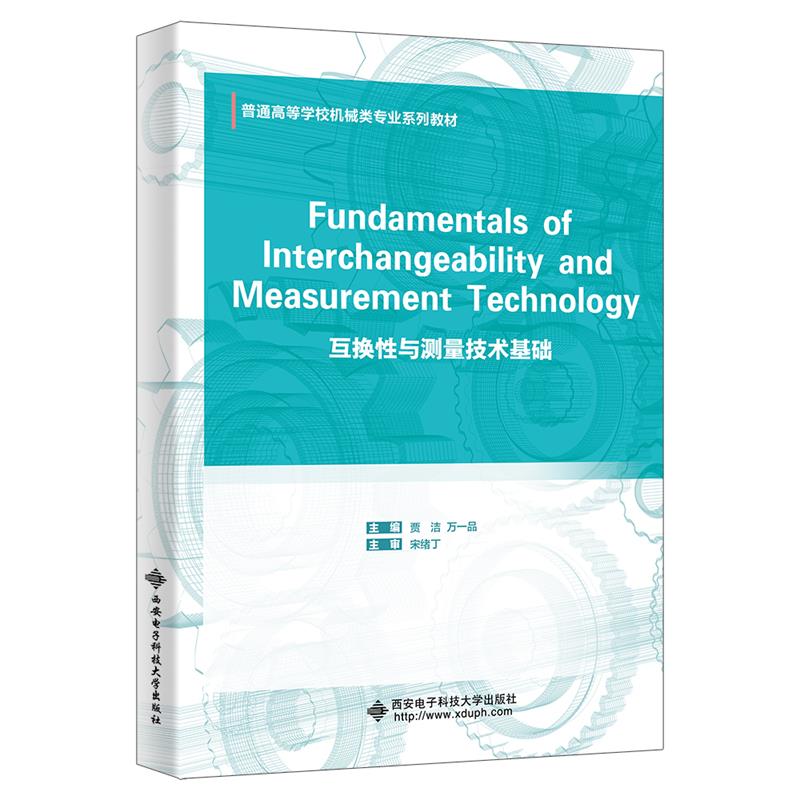- 化学工业出版社
- 9787122385390
- 1版
- 371637
- 48250735-7
- 16开
- 2021-07
- 470
- 280
- 理学
- 化学
- ①O64
- 化学类
- 本科
作者简介
内容简介
本书分九章,首先以热力学的三个基本定律为基础,研究宏观化学体系在气态、液态、固态、溶解态等平衡态物理化学性质及其规律性;然后研究由于化学或物理因素的扰动而引起的体系的化学变化过程速率和变化机理。每一章都包含例题和习题,以便读者理解并运用相关知识点。
目录
Chapter 1 The Properties of Gases 1
1.1 State Equation of the Ideal Gas 1
1.1.1 Empirical Laws of Gases 1
1.1.2 State Equation of Ideal Gas 2
1.1.3 Model and Definition of Ideal Gas 4
1.2 The Properties of Mixtures of the Ideal Gases 5
1.2.1 Composition of Mixtures 5
1.2.2 Dalton’s Law of Partial Pressures 6
1.2.3 Amagat’s Law of Partial Volumes 7
1.3 State Equations of Real Gas 8
1.3.1 The van der Waals Equation 8
1.3.2 Generalized Equation of State for Real Gases 9
1.4 Isothermal Curves and Liquefaction of Real Gas 10
1.4.1 Saturated Vapor Pressure of the Liquid 10
1.4.2 Isothermal Curves and Liquefaction 12
1.4.3 Critical Parameters and Critical Compression Factor Zc 14
1.5 Exercises 15
Chapter 2 The First Law of Thermodynamics 17
2.1 Basic Concepts 17
2.1.1 System and Surroundings 17
2.1.2 Property, State, and State Function 18
2.1.3 Process and Route 19
2.1.4 Work, Heat, and Energy 20
2.2 The First Law of Thermodynamics 22
2.2.1 The First Law of Thermodynamics 22
2.2.2 Internal Energy 23
2.3 Heat, Enthalpy, and Heat Capacities 23
2.3.1 Heat in Isochoric Conditions, and Internal Energy 23
2.3.2 Heat in Isobaric Conditions, and Enthalpy 25
2.3.3 Hess’s Law 26
2.3.4 Heat Capacities 27
2.4 Pressure-Volume Work and Reversible Processes 29
2.4.1 Pressure-Volume Work 29
2.4.2 Reversible Processes 30
2.5 Isoenthalpic Processes 36
2.5.1 The Joule-Thomson Effect 36
2.5.2 Adiabatic Joule-Thomson Coefficient 37
2.6 Thermochemistry 37
2.6.1 Standard Enthalpy of Formation 38
2.6.2 Enthalpy of Reaction 39
2.6.3 Temperature-Dependence of Standard Enthalpy of Reaction 40
2.7 Exercises 41
Chapter 3 The Second Law of Thermodynamics 42
3.1 Statements of the Second Law of Thermodynamics 42
3.1.1 Spontaneous Process 42
3.1.2 Conversion of Heat and Work 43
3.1.3 Statements of the Second Law of Thermodynamics 43
3.2 Carnot Cycle and Carnot Theorem 44
3.2.1 Carnot Cycle 44
3.2.2 Carnot Theorem 45
3.3 Entropy and Clausius Inequality 46
3.3.1 Derivation and Definition of Entropy 46
3.3.2 The Clausius Inequality 47
3.3.3 The Principle of the Increase of Entropy 47
3.3.4 Physical Significance of Entropy 48
3.4 The Calculation of Entropy Changes 49
3.4.1 The Calculation of Entropy Changes in Simple pVT Process 49
3.4.2 The Calculation of Entropy Changes for Phase Changes 51
3.5 The Standard Molar Reaction Entropy Change of Chemical Reaction 52
3.5.1 The Third Law of Thermodynamics 52
3.5.2 Absolute Entropy and Standard Molar Entropy of Matter 52
3.5.3 Calculation of Entropy Changes for Chemical Reactions 53
3.6 The Gibbs and Helmholtz Functions 55
3.6.1 Helmholtz Function 55
3.6.2 Gibbs Function 56
3.7 The Calculation of ΔA and ΔG 57
3.7.1 Simple pVT Change Process 57
3.7.2 Phase Change Processes 57
3.7.3 Chemical Change Processes 58
3.8 The Fundamental Equation of Thermodynamics 59
3.8.1 The Fundamental Equations of Thermodynamics 59
3.8.2 The Relations of Characteristic Function 60
3.8.3 The Maxwell Relations 61
3.9 The Application of the Second Law of Thermodynamics in the Phase Equilibria of Single Component Systems 62
3.9.1 The Clapeyron Equation 62
3.9.2 The Clausius-Clapeyron Equation 63
3.9.3 The Effect of Total Pressure on the Vapor Pressure 64
3.10 Exercises 65
Chapter 4 The Thermodynamics of Multi-Component Systems 68
4.1 Composition scale of multi-component systems 68
4.1.1 Mass Concentration 68
4.1.2 Amount of Substance concentration 68
4.1.3 Molality 69
4.2 Partial Molar Quantities 69
4.2.1 Definition of Partial Molar Quantity 70
4.2.2 Collected Formula of Partial Molar Quantity 71
4.2.3 The Gibbs-Duhem Equation 71
4.3 Chemical Potential 72
4.3.1 Definition of Chemical Potential 72
4.3.2 Equilibrium Criterion of Material 73
4.3.3 Application of Chemical Potential in Phase Equilibrium 74
4.4 Chemical Potential of Gas 75
4.4.1 Chemical Potential of a Pure Ideal Gas 75
4.4.2 Chemical Potentials in an Ideal Gas Mixture 76
4.5 Raoult’s law and Henry’s law 77
4.5.1 Raoult’s Law 77
4.5.2 Henry’s Law 78
4.5.3 Comparison of Raoult’s Law and Henry’s Law 79
4.6 Mixture of Ideal Liquid 79
4.6.1 Definition and Features of Mixture of Ideal Liquid 79
4.6.2 Chemical Potential of Arbitrary Component in Mixture of Ideal Liquid 80
4.6.3 Mixing Properties of Mixture of Ideal Liquid 81
4.7 Ideal Dilute Solution 82
4.7.1 Definition of Ideal Dilute Solution 82
4.7.2 Chemical Potential of the Solvent and Solute in Ideal Dilute Solution 82
4.8 Real Liquid Solution 83
4.8.1 The Solvent Activity 83
4.8.2 The Solute Activity 84
4.9 Colligative Properties 84
4.9.1 Depression of Vapor Pressure (Vapor Pressure of Solvent A) 85
4.9.2 Depression of Freezing Point 85
4.9.3 Elevation of Boiling Point 87
4.9.4 Osmotic Pressure 89
4.10 Exercises 90
Chapter 5 Chemical Equilibrium 92
5.1 Direction of Chemical Reaction and Condition of Equilibrium 92
5.1.1 Relationship between Condition of Equilibrium and Extent of Chemical Reaction 92
5.1.2 Chemical Affinity and Direction of Chemical Reaction 93
5.2 Equilibrium Constant Expressions for Gas Reaction 95
5.2.1 Isothermal Equation for Ideal Gas Reaction 95
5.2.2 Standard Equilibrium Constant Expression for Ideal Gas Reaction 96
5.2.3 Standard Equilibrium Constant Expression for Ideal Gas Reaction involving Pure Condensed Matter 97
5.2.4 Other Equilibrium Constant Expressions for Ideal Gas Reaction 99
5.2.5 Relationship between Dissociation Pressure and Standard Equilibrium Constant for Dissociation Reaction of Solid 100
5.2.6 Inherent Relation between Standard Equilibrium Constants of Relative Reactions 101
5.3 Calculation of Chemical Equilibrium 102
5.3.1 Calculation of Standard Molar Gibbs Function Change of Reaction and Standard Equilibrium Constant 102
5.3.2 Calculation of Equilibrium Composition of System and Equilibrium Conversion of Reactant 104
5.4 Response of Equilibrium to Conditions 106
5.4.1 Response of Equilibrium to Temperature 106
5.4.2 Response of Equilibrium to Pressure 107
5.4.3 Response of Equilibrium to Inert Component 108
5.4.4 Response of Equilibrium to Starting Materials Ratio 108
5.5 Exercises 109
Chapter 6 Phase Equilibrium 112
6.1 Phase Rule 113
6.1.1 Basic Concept 113
6.1.2 Phase Rule 114
6.2 Phase Diagram of One-Component System 116
6.2.1 Phase Diagram of Water 117
6.2.2 Phase Diagram of Sulfur 119
6.3 Gas-Liquid Phase Diagram of Two-Component Ideal Liquid Mixture System 120
6.3.1 Pressure-composition Phase Diagram 121
6.3.2 Lever Rule 123
6.3.3 Temperature-composition Phase Diagram 123
6.4 Gas-Liquid Phase Diagram of Two-Component Real Liquid Mixture System 124
6.4.1 Pressure-composition Phase Diagram 124
6.4.2 Temperature-composition Phase Diagram 126
6.5 Distillation Principle 128
6.6 Gas-Liquid Phase Diagrams of Partially Miscible and Nonmiscible Two-Component Liquid Systems 130
6.6.1 Solubility Relation of Partially Miscible Liquids 130
6.6.2 Temperature-composition Phase Diagrams of Partially Miscible Systems 131
6.6.3 Temperature-composition Phase Diagram of Nonmiscible System 131
6.7 Liquid-Solid Phase Diagram of Two-Component Condensed System with Solid-Phase Immiscibility 132
6.7.1 Phase Diagram Analysis 133
6.7.2 Thermal Analysis Method 134
6.7.3 Solubility Method 137
6.8 Liquid-Solid Phase Diagram of Condensed System for the Formation of Compounds 138
6.8.1 Liquid-solid Phase Diagram for the Formation of a Stable Compound System 138
6.8.2 Liquid-solid Phase Diagram for the Formation of an Unstable Compound System 139
6.9 Liquid-Solid Phase Diagram of Two-Component Condensed Systems with Solid-Phase Miscibility and Partial Miscibility 140
6.9.1 Liquid-solid Phase Diagram of Solid-phase Complete Miscibility System 140
6.9.2 Liquid-solid Phase Diagram of Solid-phase Partially Miscible System 141
6.10 Liquid-Solid Phase Diagram of Two-Component Systems with Solid-Phase Immiscible and Liquid-Phase Miscible 143
6.11 Liquid-Liquid Equilibrium Phase Diagram for Three-Component System 145
6.11.1 Graphical Representation of a Three-component System 145
6.11.2 Liquid-liquid Phase Diagram of Three-liquid System with One Pair of Partially Soluble Liquids at Constant Temperature 147
6.12 Exercises 147
Chapter 7 Electrochemistry 153
7.1 Basic Concepts and Faraday's Law 155
7.1.1 Electrolyte and Types of Electrolyte 155
7.1.2 Galvanic Cell, Electrolytic Cell and Conductance Mechanism of Electrolyte Solution 155
7.1.3 Faraday’s Law 158
7.2 Mobility and Transference Number of Ions 160
7.2.1 Mobility and Transference Number of Ions 160
7.2.2 Determination of Transference Numbers of Ions 164
7.3 Conductance, Conductivity and Molar Conductivity 165
7.3.1 Conductance and Conductivity 166
7.3.2 Measurement of Conductance 168
7.3.3 Molar Conductivity and Its Relation to the Concentration of Electrolyte Solution 169
7.3.4 Law of the Independent Migration of Ions and Limiting Molar Conductivity of Ions 171
7.4 Application of Conductance Measurement 174
7.4.1 Calculate the Degree of Dissociation and the Dissociation Constant of Weak Electrolyte 174
7.4.2 Calculate the Solubility of Insoluble Salts 176
7.4.3 Conductance Titration 177
7.5 Activities and Activity Coefficients of Electrolyte Solution 178
7.5.1 Mean Ionic Activity and Mean Ionic Activity Coefficient 178
7.5.2 Ionic Intensity I 180
7.5.3 Debye-Hückel Theory to Calculating γ± 181
7.6 Reversible Galvanic Cell 184
7.6.1 Galvanic Cell and Its Representation 185
7.6.2 Preconditions for Being a Reversible Cell 188
7.6.3 Weston Standard Cell 189
7.7 Thermodynamics of Reversible Galvanic Cells 190
7.7.1 Calculating the Change of Molar Gibbs Function of Cell Reaction ΔrGm from the Reversible E of Cell 190
7.7.2 Calculating the Molar Reaction Entropy of Cell Reaction ΔrSm from Temperature Coefficient of E 191
7.7.3 Calculating the Molar Reaction Enthalpy of Cell Reaction ΔrHm 191
7.7.4 Calculating the Thermal Effect of the Reversible Discharge Process of a Galvanic Cell Qr,m 192
7.7.5 The Nernst Equation of Cell Reaction 193
7.8 Electrode Potential and the Electromotive Force of Cell 196
7.8.1 Electrode Potential 196
7.8.2 Nernst Equation for Electrode Potential 197
7.8.3 Calculation of Electromotive Force for Galvanic Cell 200
7.8.4 Liquid-junction Potential and Its Elimination 202
7.9 Types of Reversible electrodes 204
7.9.1 First-class Electrodes 204
7.9.2 Second-class Electrodes 205
7.9.3 Third-class Electrodes 206
7.9.4 Ion-selective Electrode 207
7.10 Design of Galvanic Cell 208
7.10.1 Redox Reactions 208
7.10.2 Neutralization Reaction 209
7.10.3 Precipitation Reaction 209
7.10.4 Diffusion Process 209
7.11 Determination and Application of Electromotive Force of Reversible Cell 210
7.11.1 The Principle of EMF Measurement 210
7.11.2 Determination of the Mean ionic Activity Coefficients γ± 211
7.11.3 Determination of the Standard Equilibrium Constant K and the Solubility Product Kap of Insoluble Salt 211
7.11.4 Measurement of pH 213
7.12 Electrolytic Cell and Decomposition Voltage 214
7.12.1 Electrolytic Cell and Decomposition Voltage 214
7.12.2 Polarization 216
7.12.3 Electrode Reaction in Electrolysis 220
7.13 Exercises 221
Chapter 8 Chemical Kinetics 226
8.1 The Rates of Reactions 226
8.1.1 The definition of rate 226
8.1.2 The Determination of Rate 228
8.2 The Rate Laws of Reactions 228
8.2.1 The Reaction Mechanism and Elementary Reactions 228
8.2.2 Rate Laws of Reactions 229
8.2.3 Rate Laws of Gas-Phase Reactions 230
8.3 Integrated Rate Laws of Reactions with Simple Orders 230
8.3.1 Zeroth-Order Reactions 230
8.3.2 First-Order Reactions 231
8.3.3 Second-Order Reactions 232
8.3.4 nth-Order Reactions 233
8.4 Determination of Reaction Orders 234
8.4.1 The Method of Integrated Rate Laws 234
8.4.2 The Method of Differential Rate Laws 234
8.4.3 The Method of Half-Lifes 235
8.4.4 The Method of Initial Rates 235
8.5 The Effect of Temperature on Reaction Rates 236
8.5.1 The Arrhenius Equation 236
8.5.2 The Activation Energy 237
8.5.3 Apparent Activation Energy 237
8.5.4 Relationship between the Activation Energy and the Reaction Heat 238
8.6 Typical Complex Reactions 239
8.6.1 Opposing Reactions 239
8.6.2 Parallel Reactions 240
8.6.3 Consecutive Reactions 240
8.7 Approximations for Complex Reactions 241
8.7.1 The Rate-Determining Step Approximation 241
8.7.2 The Equilibrium-State Approximation 242
8.7.3 The Steady-State Approximation 242
8.8 Exercises 242
Chapter 9 Interface Chemistry 246
9.1 Interfacial Tension 247
9.1.1 Surface Tension, Surface Work, and the Surface Gibbs Function of the Liquid 247
9.1.2 Surface Thermodynamic Fundamental Equation 249
9.1.3 Factors Affecting Interfacial Tensions 250
9.2 Excess Pressure at Curved Liquid Surface and Capillarity 251
9.2.1 Excess Pressure at Curved Liquid Surface 251
9.2.2 Capillarity Action 253
9.3 Kelvin Equation and Metastable State 254
9.3.1 The Vapour Pressure over A Small Droplet ——the Kelvin Equation 254
9.3.2 Metastable State and the Generation of New Phases 255
9.4 Adsorption on Solids Surface 257
9.4.1 Physical Adsorption and Chemisorption 258
9.4.2 Amount of Adsorption and Isotherm Equations 259
9.4.3 Adsorption Isotherm Equations 260
9.4.4 Thermodynamics of Adsorption 264
9.5 The Solid-Liquid Interface and Wetting Phenomenon 264
9.5.1 Wetting Phenomenon 264
9.5.2 Contact Angle and Young Equation 266
9.6 Adsorption of Solution Surface 268
9.6.1 Adsorption Phenomena at Solution Surface 268
9.6.2 Surface Adsorption and Gibbs Adsorption Isotherm 269
9.6.3 Directional Arrangement of Surfactants in Adsorption Layer 270
9.7 Exercises 272
Appendix 275
Appendix Ⅰ Critical Parameters of Certain Substances 275
Appendix Ⅱ Van der Waals Constants of Certain Gases 275
Appendix Ⅲ The Relationship between the Molar Heat Capacity of Certain Gases and the Temperature 276
Appendix Ⅳ Standard Molar Formation Enthalpy, Standard Molar Formation Gibbs Function, Standard Molar Entropy and Molar Constant Pressure Heat Capacity of Certain Substances 277
Appendix Ⅴ Standard Molar Combustion Enthalpy of Certain Organic Compounds 278
Reference 280
1.1 State Equation of the Ideal Gas 1
1.1.1 Empirical Laws of Gases 1
1.1.2 State Equation of Ideal Gas 2
1.1.3 Model and Definition of Ideal Gas 4
1.2 The Properties of Mixtures of the Ideal Gases 5
1.2.1 Composition of Mixtures 5
1.2.2 Dalton’s Law of Partial Pressures 6
1.2.3 Amagat’s Law of Partial Volumes 7
1.3 State Equations of Real Gas 8
1.3.1 The van der Waals Equation 8
1.3.2 Generalized Equation of State for Real Gases 9
1.4 Isothermal Curves and Liquefaction of Real Gas 10
1.4.1 Saturated Vapor Pressure of the Liquid 10
1.4.2 Isothermal Curves and Liquefaction 12
1.4.3 Critical Parameters and Critical Compression Factor Zc 14
1.5 Exercises 15
Chapter 2 The First Law of Thermodynamics 17
2.1 Basic Concepts 17
2.1.1 System and Surroundings 17
2.1.2 Property, State, and State Function 18
2.1.3 Process and Route 19
2.1.4 Work, Heat, and Energy 20
2.2 The First Law of Thermodynamics 22
2.2.1 The First Law of Thermodynamics 22
2.2.2 Internal Energy 23
2.3 Heat, Enthalpy, and Heat Capacities 23
2.3.1 Heat in Isochoric Conditions, and Internal Energy 23
2.3.2 Heat in Isobaric Conditions, and Enthalpy 25
2.3.3 Hess’s Law 26
2.3.4 Heat Capacities 27
2.4 Pressure-Volume Work and Reversible Processes 29
2.4.1 Pressure-Volume Work 29
2.4.2 Reversible Processes 30
2.5 Isoenthalpic Processes 36
2.5.1 The Joule-Thomson Effect 36
2.5.2 Adiabatic Joule-Thomson Coefficient 37
2.6 Thermochemistry 37
2.6.1 Standard Enthalpy of Formation 38
2.6.2 Enthalpy of Reaction 39
2.6.3 Temperature-Dependence of Standard Enthalpy of Reaction 40
2.7 Exercises 41
Chapter 3 The Second Law of Thermodynamics 42
3.1 Statements of the Second Law of Thermodynamics 42
3.1.1 Spontaneous Process 42
3.1.2 Conversion of Heat and Work 43
3.1.3 Statements of the Second Law of Thermodynamics 43
3.2 Carnot Cycle and Carnot Theorem 44
3.2.1 Carnot Cycle 44
3.2.2 Carnot Theorem 45
3.3 Entropy and Clausius Inequality 46
3.3.1 Derivation and Definition of Entropy 46
3.3.2 The Clausius Inequality 47
3.3.3 The Principle of the Increase of Entropy 47
3.3.4 Physical Significance of Entropy 48
3.4 The Calculation of Entropy Changes 49
3.4.1 The Calculation of Entropy Changes in Simple pVT Process 49
3.4.2 The Calculation of Entropy Changes for Phase Changes 51
3.5 The Standard Molar Reaction Entropy Change of Chemical Reaction 52
3.5.1 The Third Law of Thermodynamics 52
3.5.2 Absolute Entropy and Standard Molar Entropy of Matter 52
3.5.3 Calculation of Entropy Changes for Chemical Reactions 53
3.6 The Gibbs and Helmholtz Functions 55
3.6.1 Helmholtz Function 55
3.6.2 Gibbs Function 56
3.7 The Calculation of ΔA and ΔG 57
3.7.1 Simple pVT Change Process 57
3.7.2 Phase Change Processes 57
3.7.3 Chemical Change Processes 58
3.8 The Fundamental Equation of Thermodynamics 59
3.8.1 The Fundamental Equations of Thermodynamics 59
3.8.2 The Relations of Characteristic Function 60
3.8.3 The Maxwell Relations 61
3.9 The Application of the Second Law of Thermodynamics in the Phase Equilibria of Single Component Systems 62
3.9.1 The Clapeyron Equation 62
3.9.2 The Clausius-Clapeyron Equation 63
3.9.3 The Effect of Total Pressure on the Vapor Pressure 64
3.10 Exercises 65
Chapter 4 The Thermodynamics of Multi-Component Systems 68
4.1 Composition scale of multi-component systems 68
4.1.1 Mass Concentration 68
4.1.2 Amount of Substance concentration 68
4.1.3 Molality 69
4.2 Partial Molar Quantities 69
4.2.1 Definition of Partial Molar Quantity 70
4.2.2 Collected Formula of Partial Molar Quantity 71
4.2.3 The Gibbs-Duhem Equation 71
4.3 Chemical Potential 72
4.3.1 Definition of Chemical Potential 72
4.3.2 Equilibrium Criterion of Material 73
4.3.3 Application of Chemical Potential in Phase Equilibrium 74
4.4 Chemical Potential of Gas 75
4.4.1 Chemical Potential of a Pure Ideal Gas 75
4.4.2 Chemical Potentials in an Ideal Gas Mixture 76
4.5 Raoult’s law and Henry’s law 77
4.5.1 Raoult’s Law 77
4.5.2 Henry’s Law 78
4.5.3 Comparison of Raoult’s Law and Henry’s Law 79
4.6 Mixture of Ideal Liquid 79
4.6.1 Definition and Features of Mixture of Ideal Liquid 79
4.6.2 Chemical Potential of Arbitrary Component in Mixture of Ideal Liquid 80
4.6.3 Mixing Properties of Mixture of Ideal Liquid 81
4.7 Ideal Dilute Solution 82
4.7.1 Definition of Ideal Dilute Solution 82
4.7.2 Chemical Potential of the Solvent and Solute in Ideal Dilute Solution 82
4.8 Real Liquid Solution 83
4.8.1 The Solvent Activity 83
4.8.2 The Solute Activity 84
4.9 Colligative Properties 84
4.9.1 Depression of Vapor Pressure (Vapor Pressure of Solvent A) 85
4.9.2 Depression of Freezing Point 85
4.9.3 Elevation of Boiling Point 87
4.9.4 Osmotic Pressure 89
4.10 Exercises 90
Chapter 5 Chemical Equilibrium 92
5.1 Direction of Chemical Reaction and Condition of Equilibrium 92
5.1.1 Relationship between Condition of Equilibrium and Extent of Chemical Reaction 92
5.1.2 Chemical Affinity and Direction of Chemical Reaction 93
5.2 Equilibrium Constant Expressions for Gas Reaction 95
5.2.1 Isothermal Equation for Ideal Gas Reaction 95
5.2.2 Standard Equilibrium Constant Expression for Ideal Gas Reaction 96
5.2.3 Standard Equilibrium Constant Expression for Ideal Gas Reaction involving Pure Condensed Matter 97
5.2.4 Other Equilibrium Constant Expressions for Ideal Gas Reaction 99
5.2.5 Relationship between Dissociation Pressure and Standard Equilibrium Constant for Dissociation Reaction of Solid 100
5.2.6 Inherent Relation between Standard Equilibrium Constants of Relative Reactions 101
5.3 Calculation of Chemical Equilibrium 102
5.3.1 Calculation of Standard Molar Gibbs Function Change of Reaction and Standard Equilibrium Constant 102
5.3.2 Calculation of Equilibrium Composition of System and Equilibrium Conversion of Reactant 104
5.4 Response of Equilibrium to Conditions 106
5.4.1 Response of Equilibrium to Temperature 106
5.4.2 Response of Equilibrium to Pressure 107
5.4.3 Response of Equilibrium to Inert Component 108
5.4.4 Response of Equilibrium to Starting Materials Ratio 108
5.5 Exercises 109
Chapter 6 Phase Equilibrium 112
6.1 Phase Rule 113
6.1.1 Basic Concept 113
6.1.2 Phase Rule 114
6.2 Phase Diagram of One-Component System 116
6.2.1 Phase Diagram of Water 117
6.2.2 Phase Diagram of Sulfur 119
6.3 Gas-Liquid Phase Diagram of Two-Component Ideal Liquid Mixture System 120
6.3.1 Pressure-composition Phase Diagram 121
6.3.2 Lever Rule 123
6.3.3 Temperature-composition Phase Diagram 123
6.4 Gas-Liquid Phase Diagram of Two-Component Real Liquid Mixture System 124
6.4.1 Pressure-composition Phase Diagram 124
6.4.2 Temperature-composition Phase Diagram 126
6.5 Distillation Principle 128
6.6 Gas-Liquid Phase Diagrams of Partially Miscible and Nonmiscible Two-Component Liquid Systems 130
6.6.1 Solubility Relation of Partially Miscible Liquids 130
6.6.2 Temperature-composition Phase Diagrams of Partially Miscible Systems 131
6.6.3 Temperature-composition Phase Diagram of Nonmiscible System 131
6.7 Liquid-Solid Phase Diagram of Two-Component Condensed System with Solid-Phase Immiscibility 132
6.7.1 Phase Diagram Analysis 133
6.7.2 Thermal Analysis Method 134
6.7.3 Solubility Method 137
6.8 Liquid-Solid Phase Diagram of Condensed System for the Formation of Compounds 138
6.8.1 Liquid-solid Phase Diagram for the Formation of a Stable Compound System 138
6.8.2 Liquid-solid Phase Diagram for the Formation of an Unstable Compound System 139
6.9 Liquid-Solid Phase Diagram of Two-Component Condensed Systems with Solid-Phase Miscibility and Partial Miscibility 140
6.9.1 Liquid-solid Phase Diagram of Solid-phase Complete Miscibility System 140
6.9.2 Liquid-solid Phase Diagram of Solid-phase Partially Miscible System 141
6.10 Liquid-Solid Phase Diagram of Two-Component Systems with Solid-Phase Immiscible and Liquid-Phase Miscible 143
6.11 Liquid-Liquid Equilibrium Phase Diagram for Three-Component System 145
6.11.1 Graphical Representation of a Three-component System 145
6.11.2 Liquid-liquid Phase Diagram of Three-liquid System with One Pair of Partially Soluble Liquids at Constant Temperature 147
6.12 Exercises 147
Chapter 7 Electrochemistry 153
7.1 Basic Concepts and Faraday's Law 155
7.1.1 Electrolyte and Types of Electrolyte 155
7.1.2 Galvanic Cell, Electrolytic Cell and Conductance Mechanism of Electrolyte Solution 155
7.1.3 Faraday’s Law 158
7.2 Mobility and Transference Number of Ions 160
7.2.1 Mobility and Transference Number of Ions 160
7.2.2 Determination of Transference Numbers of Ions 164
7.3 Conductance, Conductivity and Molar Conductivity 165
7.3.1 Conductance and Conductivity 166
7.3.2 Measurement of Conductance 168
7.3.3 Molar Conductivity and Its Relation to the Concentration of Electrolyte Solution 169
7.3.4 Law of the Independent Migration of Ions and Limiting Molar Conductivity of Ions 171
7.4 Application of Conductance Measurement 174
7.4.1 Calculate the Degree of Dissociation and the Dissociation Constant of Weak Electrolyte 174
7.4.2 Calculate the Solubility of Insoluble Salts 176
7.4.3 Conductance Titration 177
7.5 Activities and Activity Coefficients of Electrolyte Solution 178
7.5.1 Mean Ionic Activity and Mean Ionic Activity Coefficient 178
7.5.2 Ionic Intensity I 180
7.5.3 Debye-Hückel Theory to Calculating γ± 181
7.6 Reversible Galvanic Cell 184
7.6.1 Galvanic Cell and Its Representation 185
7.6.2 Preconditions for Being a Reversible Cell 188
7.6.3 Weston Standard Cell 189
7.7 Thermodynamics of Reversible Galvanic Cells 190
7.7.1 Calculating the Change of Molar Gibbs Function of Cell Reaction ΔrGm from the Reversible E of Cell 190
7.7.2 Calculating the Molar Reaction Entropy of Cell Reaction ΔrSm from Temperature Coefficient of E 191
7.7.3 Calculating the Molar Reaction Enthalpy of Cell Reaction ΔrHm 191
7.7.4 Calculating the Thermal Effect of the Reversible Discharge Process of a Galvanic Cell Qr,m 192
7.7.5 The Nernst Equation of Cell Reaction 193
7.8 Electrode Potential and the Electromotive Force of Cell 196
7.8.1 Electrode Potential 196
7.8.2 Nernst Equation for Electrode Potential 197
7.8.3 Calculation of Electromotive Force for Galvanic Cell 200
7.8.4 Liquid-junction Potential and Its Elimination 202
7.9 Types of Reversible electrodes 204
7.9.1 First-class Electrodes 204
7.9.2 Second-class Electrodes 205
7.9.3 Third-class Electrodes 206
7.9.4 Ion-selective Electrode 207
7.10 Design of Galvanic Cell 208
7.10.1 Redox Reactions 208
7.10.2 Neutralization Reaction 209
7.10.3 Precipitation Reaction 209
7.10.4 Diffusion Process 209
7.11 Determination and Application of Electromotive Force of Reversible Cell 210
7.11.1 The Principle of EMF Measurement 210
7.11.2 Determination of the Mean ionic Activity Coefficients γ± 211
7.11.3 Determination of the Standard Equilibrium Constant K and the Solubility Product Kap of Insoluble Salt 211
7.11.4 Measurement of pH 213
7.12 Electrolytic Cell and Decomposition Voltage 214
7.12.1 Electrolytic Cell and Decomposition Voltage 214
7.12.2 Polarization 216
7.12.3 Electrode Reaction in Electrolysis 220
7.13 Exercises 221
Chapter 8 Chemical Kinetics 226
8.1 The Rates of Reactions 226
8.1.1 The definition of rate 226
8.1.2 The Determination of Rate 228
8.2 The Rate Laws of Reactions 228
8.2.1 The Reaction Mechanism and Elementary Reactions 228
8.2.2 Rate Laws of Reactions 229
8.2.3 Rate Laws of Gas-Phase Reactions 230
8.3 Integrated Rate Laws of Reactions with Simple Orders 230
8.3.1 Zeroth-Order Reactions 230
8.3.2 First-Order Reactions 231
8.3.3 Second-Order Reactions 232
8.3.4 nth-Order Reactions 233
8.4 Determination of Reaction Orders 234
8.4.1 The Method of Integrated Rate Laws 234
8.4.2 The Method of Differential Rate Laws 234
8.4.3 The Method of Half-Lifes 235
8.4.4 The Method of Initial Rates 235
8.5 The Effect of Temperature on Reaction Rates 236
8.5.1 The Arrhenius Equation 236
8.5.2 The Activation Energy 237
8.5.3 Apparent Activation Energy 237
8.5.4 Relationship between the Activation Energy and the Reaction Heat 238
8.6 Typical Complex Reactions 239
8.6.1 Opposing Reactions 239
8.6.2 Parallel Reactions 240
8.6.3 Consecutive Reactions 240
8.7 Approximations for Complex Reactions 241
8.7.1 The Rate-Determining Step Approximation 241
8.7.2 The Equilibrium-State Approximation 242
8.7.3 The Steady-State Approximation 242
8.8 Exercises 242
Chapter 9 Interface Chemistry 246
9.1 Interfacial Tension 247
9.1.1 Surface Tension, Surface Work, and the Surface Gibbs Function of the Liquid 247
9.1.2 Surface Thermodynamic Fundamental Equation 249
9.1.3 Factors Affecting Interfacial Tensions 250
9.2 Excess Pressure at Curved Liquid Surface and Capillarity 251
9.2.1 Excess Pressure at Curved Liquid Surface 251
9.2.2 Capillarity Action 253
9.3 Kelvin Equation and Metastable State 254
9.3.1 The Vapour Pressure over A Small Droplet ——the Kelvin Equation 254
9.3.2 Metastable State and the Generation of New Phases 255
9.4 Adsorption on Solids Surface 257
9.4.1 Physical Adsorption and Chemisorption 258
9.4.2 Amount of Adsorption and Isotherm Equations 259
9.4.3 Adsorption Isotherm Equations 260
9.4.4 Thermodynamics of Adsorption 264
9.5 The Solid-Liquid Interface and Wetting Phenomenon 264
9.5.1 Wetting Phenomenon 264
9.5.2 Contact Angle and Young Equation 266
9.6 Adsorption of Solution Surface 268
9.6.1 Adsorption Phenomena at Solution Surface 268
9.6.2 Surface Adsorption and Gibbs Adsorption Isotherm 269
9.6.3 Directional Arrangement of Surfactants in Adsorption Layer 270
9.7 Exercises 272
Appendix 275
Appendix Ⅰ Critical Parameters of Certain Substances 275
Appendix Ⅱ Van der Waals Constants of Certain Gases 275
Appendix Ⅲ The Relationship between the Molar Heat Capacity of Certain Gases and the Temperature 276
Appendix Ⅳ Standard Molar Formation Enthalpy, Standard Molar Formation Gibbs Function, Standard Molar Entropy and Molar Constant Pressure Heat Capacity of Certain Substances 277
Appendix Ⅴ Standard Molar Combustion Enthalpy of Certain Organic Compounds 278
Reference 280

